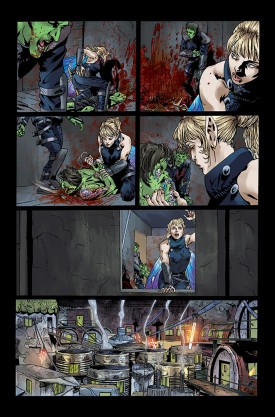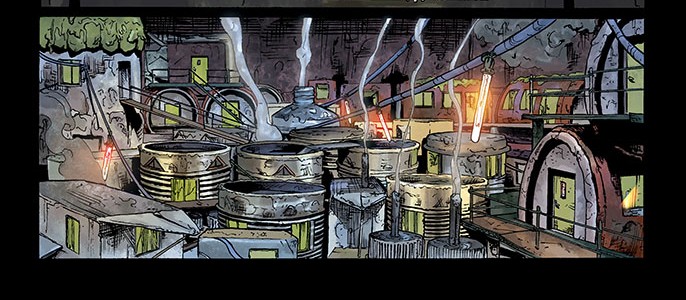INTERVIEW: Simon Spurrier on his new webcomic, ‘Disenchanted’

Avatar Press is set to release its latest webcomic on Monday, Oct. 28. Disenchanted, from Simon Spurrier of Crossed: Wish You Were Here and Six Gun Gorilla fame, follows a host of fairytale creatures, including leprechauns, pixies, goblins and fey, as they populate a world in an abandoned London Underground station. Human garbage takes on skyscraper dimensions, and these forgotten creatures begin asking questions of why they’re largely lost from the memory of the giants walking above.
Recently, Hollywood Soapbox exchanged emails with Spurrier in advance of Disenchanted’s inaugural issue. There has been slight editing to the answers.
Where did the idea for Disenchanted originate? How interested are you in folklore?
We-ell… like a lot of ideas, Disenchanted is the product of a chain-reaction of thoughts and interests. Most writers’ll tell you something similar when you ask “where do you get your ideas”? (Which of course you never should — that’s up there with “what’s it like being a woman in comics?” in the continuum of daft questions.) Ideas are all about critical mass, about disparate elements accreting, wrapping round themselves, building links.
So: Disenchanted is what happens when one brain happens to be packed with particular obsessions and interests. Tradition, culture, city-life (I’m fascinated by cities), religion, family, disenfranchisement. And, yes, folklore. I’ve always been a nut about that — most writers have that in common too — because at its most pure mythology is all about stories. Stories which were once beliefs but which have faded from the glorious heights of Faith and become daft kids’ whimsy, never to be taken seriously again.
Pretty much everything I write, one way or another, boils down to a commentary on either language or story. The way we experience the world — the uniquely human way — is that we muddle event and time and convention to create narratives. The instant that the “now” becomes then “then” it’s rendered into a story. That’s incredible and potent and special, and worth thinking about. And worth saying things about.
My other book Six-Gun Gorilla, for instance, is partially about the conventions of Genre and Narrative, and how characters feel obligated to live within those ruts, even when they don’t fit. With Disenchanted I wanted to do something broader and more subtle: a very character-led ensemble whose bubbling subtext has to do with unwanted stories.
See, folklore’s kind of the “one-hit-wonder” of the story world… in the same way that a once-famous pop star has to find new ways of living when everyone’s forgotten their name, so (I figured) all those amazing and creepy little creatures, which used to be such an important part of people’s superstitious belief systems, have to find new ways to live.
I liked the idea of playing with the way that cities evolve and corrupt beliefs. It struck me that the key to a whole host of really awesome stories was a simple conceit: if you pretend for a moment that all those forgotten sprites and spirits and goblins and brownies and leprachauns and whatnot are really real, then you have to wonder what happened to them all. Where did they go when people stopped believing them? And — more importantly — how do they feel about it? Ultimately it’s a very simple metaphor for what happens to our own beliefs and cultures when they’re all crammed together, torn down, mixed-up and confronted by harsh reality. Which happens to normal people, living as we are in the Now, every day.
So, yeah. I wanted to tell a folkloric story which totally avoided sentimentality and twee-ness, which plumbed some pretty heavy depths. But which looks amazing, feels amazing, and sucks you into a completely unique world.
When creating Vermintown, what were your inspirations?
Mostly just a lot of thinking it through. Posing questions and challenging myself to generate answers. Like… Question: where would you hide a miniature city of one million souls in London if you wanted it to stay secret? Answer: an abandoned tube station (of which there really are many — you can take tours and everything). Question: how is this city built? Answer: using the collected detritus of the human city above: soda cans, cereal boxes, milk cartons. (There was a lot of sitting around with a tape measure, working out ratios and relative occupancy rates.) Question: how come nobody’s ever discovered this city? Answer: Aha, well that’s a mystery around which you can slowly build a story… Visually speaking there was a lot of reference to South American favelas, shanty towns, slums, ghettoes, purpose-built blocks, etc. And then of course you wind up thinking about racial and class distinctions: what sort of person would live in this section of the station, what sort would live there, etc. Before long we took the decision to be utterly insane about the whole thing and generate a vast fully explorable map of the entire metropolis, which will form the centrepiece of the website when it goes live. Speaking of which —
Having the comic posted for free online is a bold step. Are you excited for this format and delivery method?
Yeah, absolutely. It’s something Avatar’s had a lot of success with before (Freakangels then Crossed: Wish You Were Here — which I also write). It seems counterintuitive, I know: you give people something for free in installments then ask them to go buy the damn thing. But it works. Partly because people are excellent and want to support their favourite publishers and creators, partly because people like to feel as though they own an artifact rather than simply dipping into it, and partly because a lot of people prefer the experience of reading a physical copy than a digital one.
Whatever the main cause, people have flocked to buy the (very beautifully produced) collected editions of Avatar’s previous web/print comics. We hope Disenchanted will be the same. But we’ve slightly ratcheted up the whole experience this time. We figured from the outset that as well as wanting to feel and experience the story of the central characters, people will be so enamoured of the detail and exoticism of this world that they’re going to want to delve deeper. By hosting the story online we’ve got a perfect opportunity to do that: making Disenchanted a far more immersive experience than any other comic. There’s the map I mentioned above — which has been a very very veeeeeery massive labour-of-love undertaking, and will blow your mind when you see it — plus there are ongoing design documents, the discussion forum on the Whitechapel boards (http://www.freakangels.com/whitechapel/) and above all we’re launching a Wiki site to build up this amazing world one article at a time. So those readers who simply can’t wait for the next episode will be able to read and explore the city to their heart’s content. It’s been a huge undertaking, but we’re all massively proud of it.
By John Soltes / Publisher / John@HollywoodSoapbox.com
-
Click here for more information on Disenchanted.

